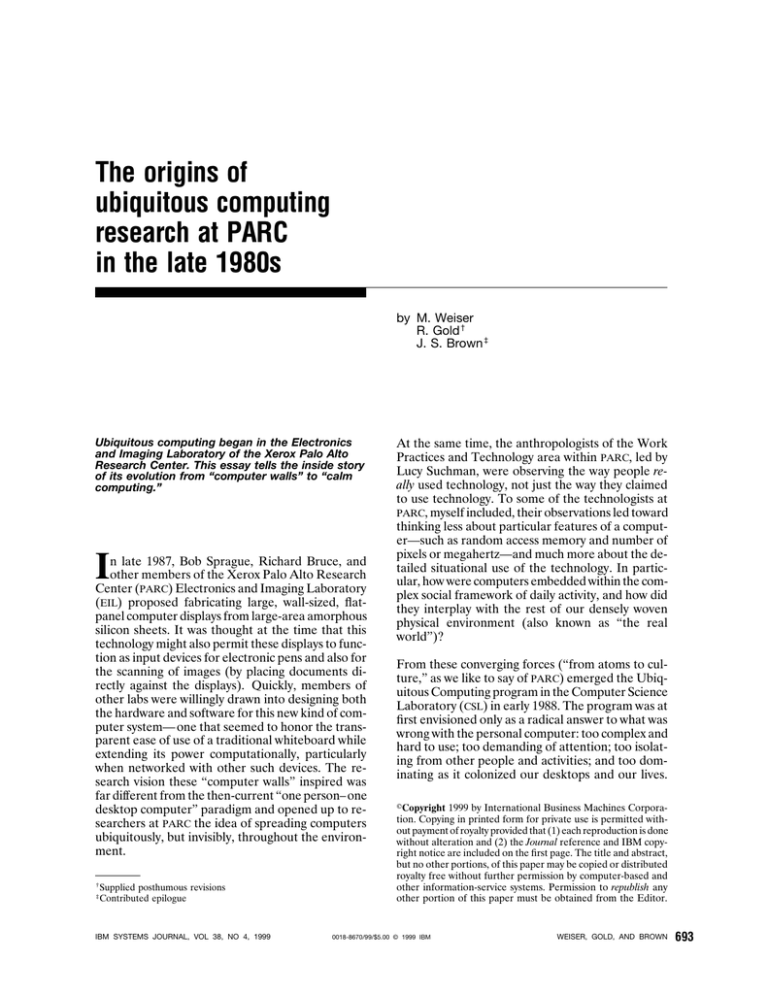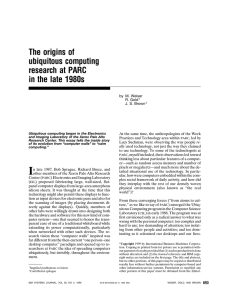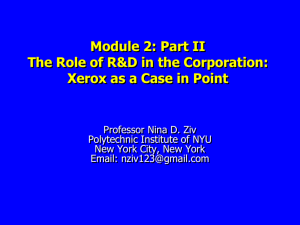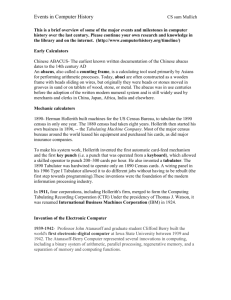The origins of ubiquitous computing research at PARC in the late
advertisement

The origins of ubiquitous computing research at PARC in the late 1980s by M. Weiser R. Gold † J. S. Brown ‡ Ubiquitous computing began in the Electronics and Imaging Laboratory of the Xerox Palo Alto Research Center. This essay tells the inside story of its evolution from “computer walls” to “calm computing.” I n late 1987, Bob Sprague, Richard Bruce, and other members of the Xerox Palo Alto Research Center (PARC) Electronics and Imaging Laboratory (EIL) proposed fabricating large, wall-sized, flatpanel computer displays from large-area amorphous silicon sheets. It was thought at the time that this technology might also permit these displays to function as input devices for electronic pens and also for the scanning of images (by placing documents directly against the displays). Quickly, members of other labs were willingly drawn into designing both the hardware and software for this new kind of computer system— one that seemed to honor the transparent ease of use of a traditional whiteboard while extending its power computationally, particularly when networked with other such devices. The research vision these “computer walls” inspired was far different from the then-current “one person– one desktop computer” paradigm and opened up to researchers at PARC the idea of spreading computers ubiquitously, but invisibly, throughout the environment. † ‡ Supplied posthumous revisions Contributed epilogue IBM SYSTEMS JOURNAL, VOL 38, NO 4, 1999 At the same time, the anthropologists of the Work Practices and Technology area within PARC, led by Lucy Suchman, were observing the way people really used technology, not just the way they claimed to use technology. To some of the technologists at PARC, myself included, their observations led toward thinking less about particular features of a computer—such as random access memory and number of pixels or megahertz—and much more about the detailed situational use of the technology. In particular, how were computers embedded within the complex social framework of daily activity, and how did they interplay with the rest of our densely woven physical environment (also known as “the real world”)? From these converging forces (“from atoms to culture,” as we like to say of PARC) emerged the Ubiquitous Computing program in the Computer Science Laboratory (CSL) in early 1988. The program was at first envisioned only as a radical answer to what was wrong with the personal computer: too complex and hard to use; too demanding of attention; too isolating from other people and activities; and too dominating as it colonized our desktops and our lives. !Copyright 1999 by International Business Machines Corporation. Copying in printed form for private use is permitted without payment of royalty provided that (1) each reproduction is done without alteration and (2) the Journal reference and IBM copyright notice are included on the first page. The title and abstract, but no other portions, of this paper may be copied or distributed royalty free without further permission by computer-based and other information-service systems. Permission to republish any other portion of this paper must be obtained from the Editor. 0018-8670/99/$5.00 © 1999 IBM WEISER, GOLD, AND BROWN 693 We wanted to put computing back in its place, to reposition it into the environmental background, to concentrate on human-to-human interfaces and less on human-to-computer ones. By 1992, when our first experimental “ubi-comp” system was being implemented, we came to realize that we were, in fact, actually redefining the entire relationship of humans, work, and technology for the post-PC era. Starting in late 1988, there emerged three intertwined major building efforts at PARC within the Ubiquitous Computing program. The large wall-display program, now known as the LiveBoard**, continued to be spearheaded from EIL, but migrated from amorphous silicon to rear screen projection. CSL initiated two programs to create smaller computers: the book-sized ParcPad** (later called the MPad**) and the palm-sized ParcTab**; both were supported, in part, by a three-year DARPA grant. Augmenting these devices was the Active Badge** system, developed originally for Olivetti by Roy Want (who had joined PARC). These programs: the board, the pad, the tab, and the badge, together with a flexible, computational infrastructure that recognized not just device name, but the location, situation, usage, connectivity, and ownership of each device, staked out a new conception of what computers could be and feel like. By 1994 these ubi-comp building programs had produced a working infrastructure for everyday use at PARC. The LiveBoard, designed primarily by Scott Elrod and Richard Bruce, was commercialized by Xerox in a subsidiary called LiveWorks. Besides the hardware, the LiveBoard came with a collaborative drawing system, spearheaded by Tom Moran, that pioneered shoulder-to-shoulder computing, remote drawing collaboration, casual interfaces, and firstclass annotation systems. LiveWorks sold hundreds of units (including units sold to high schools who found that the LiveBoards augmented, rather than replaced, the teachers) before being closed down in 1998. While the LiveBoard more traditionally plugged into the network, the ParcPad maintained constant network connectivity by using a unique “near-field radio” system designed by Ed Richley. The pad itself was based on hardware designed by Bob Krivacic, a window-and-pen interface system designed by Chris Kantarjiev, an operating system by Al Demers, as well as other components created by a wide range of PARC researchers. The pad proved an important platform for radio, protocol, mobile network694 WEISER, GOLD, AND BROWN ing, user interface, and work studies research. The pad’s operating system and hardware design have proved their robustness and are still in use in new projects at PARC today. The pad is also the clear precursor to the Personal Document Reader** (PDR) to be released by Xerox in 2000. The ParcTab, designed by Roy Want and his team, was unique in its ability to be used with one hand and its integration— using a location-sensitive, agentbased, enterprise-wide infrared network—with applications on workstations, LiveBoards, and with other devices, including the now famous CSL coffeemaker. 1 The tab came with a complete suite of realtime networked utilities including e-mail, memo, calendar, sketch pad, address book, pager, and remote drawing tool (which drew on LiveBoards). The tab’s alphanumeric input was via a patented Unistroke** system, while selections were activated by the touch screen and three ergonomically placed buttons. The tab’s simple design philosophy was later extended into other CSL projects to create, among other things, a keychain computer. The Ubiquitous Computing project at PARC resulted in many fundamental patents and papers, in a wide range of what had been at the time considered independent areas of computer science, including physical transport, network protocols, operating systems, window systems, file systems, user interfaces, energy management, and input design. In the end, ubi-comp created a new field of computer science, one that speculated on a physical world richly and invisibly interwoven with sensors, actuators, displays, and computational elements, embedded seamlessly in the everyday objects of our lives and connected through a continuous network. What is truly startling is how quickly we are finding this new form of computation manifesting itself around us. Like all great research, the Ubiquitous Computing project gave us more questions than answers. Once the infrastructure was up and running we clearly saw the vast potential of such a system for augmenting and improving work practices and knowledge sharing, by essentially getting the computers out of the way while amplifying human-to-human communication. But simultaneously we came across an unexpected problem, often blared in newspaper headlines as: “Big Brother Comes to the Office.” The problem, while often couched in terms of privacy, is really one of control. If the computational system is invisible as well as extensive, it becomes hard to know what is controlling what, what is connected to what, IBM SYSTEMS JOURNAL, VOL 38, NO 4, 1999 where information is flowing, how it is being used, what is broken (vs what is working correctly, but not helpfully), and what are the consequences of any given action (including simply walking into a room). Maintaining simplicity and control simultaneously is still one of the major open questions facing ubiquitous computing research. In the last several years a few of us at PARC have begun to speak of calm computing as the goal, describing the desired state of mind of the user, as opposed to the hardware configuration of the computer. Just as a good, well-balanced hammer “disappears” in the hands of a carpenter and allows him or her to concentrate on the big picture, we hope that computers can participate in a similar magic disappearing act. But it is not so simple. Besides the daunting computational and infrastructural problems, we must also find the balance between control and simplicity, between unlimited power and understandable straightforwardness, between the seduction of smooth digital mediation and the immediacy of those complex fellow workers called humans. But in the end, it is hard to imagine a more important task for twenty-first century technologists. **Trademark or registered trademark of LiveWorks, Inc. or Xerox Corporation. Cited note 1. We placed a ParcTab on the CSL coffeepot. Whenever anyone made a new pot of coffee we pushed the reset button on the ParcTab, which sent an infrared signal to the computer network. A message popped up on our computer screens letting everyone know that there was a fresh brew. This caused an instantaneous gathering around the coffeepot, and as a result generated lots of fresh hallway discussion—which is one of the best ways to create new research ideas. General references See http://www.ubiq.com/ for more information. S. Elrod, R. Bruce, R. Gold, D. Goldberg, F. Halasz, W. Janssen, D. Lee, K. McCall, E. Pedersen, K. Pier, J. Tang, and B. Welch. “LiveBoard: A Large Interactive Display Supporting Group Meetings, Presentations, and Remote Collaboration,” Proceedings of the Conference on Computer Human Interaction (CHI), Monterey, CA (May 4 –7, 1992), pp. 599 – 607. C. A. Kantarjiev, A. Demers, R. Frederick, R. T. Krivacic, and M. Weiser, “Experiences with X in a Wireless Environment,” Proceedings USENIX Symposium on Mobile and Location-Independent Computing, Cambridge, MA (August 2–3, 1993). R. Want, W. N. Schilit, N. I. Adams, R. Gold, K. Petersen, D. Goldberg, J. R. Ellis, and M. Weiser. “The ParcTab Ubiquitous Computing Experiment,” Mobile Computing, T. Imielinski and H. F. Korth, Editors, Kluwer Academic Publishers, Boston, MA (1996), pp. 45–102. Also available as Xerox PARC IBM SYSTEMS JOURNAL, VOL 38, NO 4, 1999 Computer Science Laboratory Technical Report CSL-95-1 (March 1995). M. Weiser, “The Computer for the 21st Century,” Scientific American 265, No. 3, 94 –104 (September 1991). M. Weiser, “Some Computer Science Problems in Ubiquitous Computing,” Communications of the ACM 36, No. 7, 74 – 83 (July 1993). M. Weiser and J. S. Brown, “The Coming Age of Calm Technology,” Beyond Calculation: The Next Fifty Years of Computing. P. Denning and R. Metcalfe, Editors, Springer-Verlag, Inc., New York (1997). Accepted for publication May 11, 1999. Epilogue On April 27, 1999, Mark Weiser passed away following a sudden encounter with cancer. Young as he was, he leaves behind many great legacies, ubiquitous computing being the one most known to the world. As this brief essay describes, his vision of ubiquitous computing transcends the issues raised by technology and searches for ways to redefine how we relate to each other, particularly in situations where computing and its various interfaces become transparent to our actions. Creating transparent computing is as much a study in phenomenology as it is of user and community interface design. For Mark, sharp boundaries between the social and the technical, between the artistic and the scientific, and between work and play never existed. He sought to create a technological world that honored the human and social spirit. We will all miss his constant drive to challenge current conceptions of computer science, human-computer interaction, and today’s computer-mediated workscapes. Perhaps it will sound like a cliché to claim that we need more like him, but let’s face it, we really, really do. John Seely Brown Mark Weiser Dr. Weiser was Chief Technologist at the Xerox Palo Alto Research Center (PARC), and prior to that headed the Computer Science Laboratory at PARC. He had no bachelor’s degree; instead he started two companies in the early 1970s, and when they both went out of business he talked his way into graduate school at the University of Michigan, earning the Ph.D. degree in computer and communications sciences in 1979. Dr. Weiser was assistant and associate professor and associate chair in the Computer Science Department at the University of Maryland from 1979 to 1987, when he joined Xerox. He published over 80 papers on the psychology of programming, program slicing, operating systems, programming environments, garbage collection, technological ethics, and new business incubation. Dr. Weiser’s work after 1988 focused on ubiquitous computing, a program he initiated. Dr. Weiser was the drummer with the rock band “Severe Tire Damage,” the first live band on the Internet. Rich Gold Xerox Palo Alto Research Center, 3333 Coyote Hill Road, Palo Alto, California 94304 (electronic mail: richgold@parc.xerox. WEISER, GOLD, AND BROWN 695 com). Mr. Gold is the manager of the “lablette” Research in Experimental Documents (RED) at the Xerox Palo Alto Research Center (PARC). He focuses his research on the future of documents and the creation of new document genres, particularly within corporate research facilities and corporate identity programs. Mr. Gold was a primary researcher on ubiquitous computing and the manager of the PARC artist-in-residence program (PAIR). Before coming to PARC, he was a toy designer at Mattel, Inc., a game designer at Sega Enterprises, Ltd., the creator of “Little Computer People,” an electronic music composer, a performance artist, and a cartoonist. He holds an M.F.A. degree in electronic music from Mills College, Oakland, California, and undergraduate degrees in English and computer science from the State University of New York at Albany. John Seely Brown Xerox Palo Alto Research Center, 3333 Coyote Hill Road, Palo Alto, California 94304 (electronic mail: jsb@parc.xerox.com). Dr. Brown is the Chief Scientist of Xerox Corporation and the Director of its Palo Alto Research Center (PARC). At Xerox, he has expanded the role of corporate research to include such topics as organizational learning, ethnographies of the workplace, complex adaptive systems, and techniques for unfreezing the corporate mind. His personal research interests include digital culture, ubiquitous computing, user-centering design, and organizational and individual learning. A major focus of his research over the years has been in human learning and in the management of radical innovation. Dr. Brown holds a B.S. degree in mathematics and physics from Brown University, and an M.S. degree in mathematics and a Ph.D. degree in computer and communication sciences from the University of Michigan. Reprint Order No. G321-5713. 696 WEISER, GOLD, AND BROWN IBM SYSTEMS JOURNAL, VOL 38, NO 4, 1999


